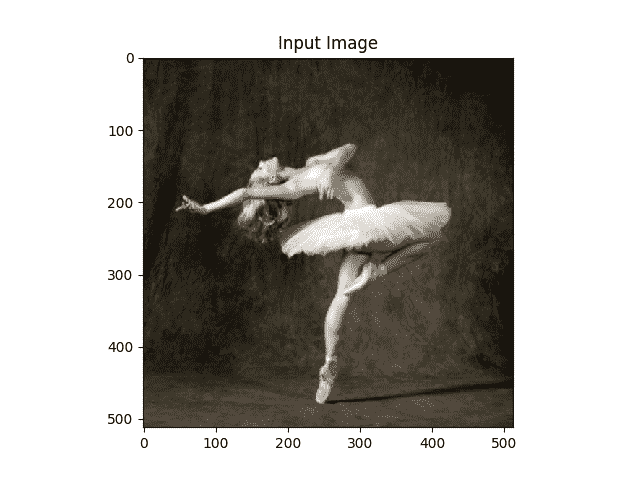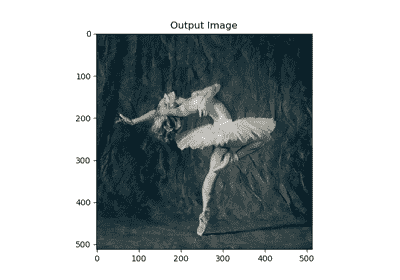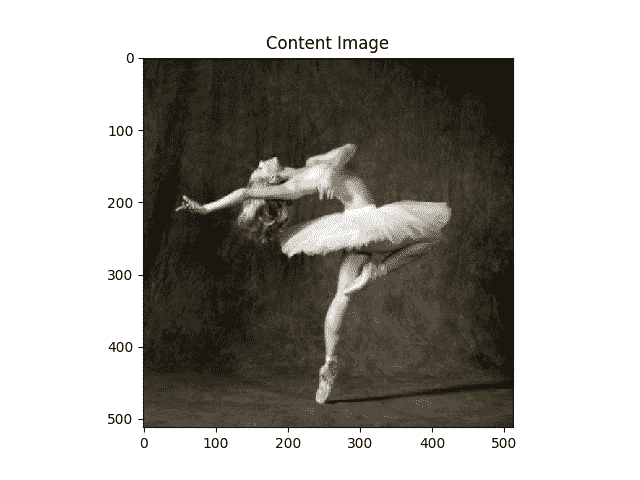使用 PyTorch 进行神经传递
原文: https://pytorch.org/tutorials/advanced/neural_style_tutorial.html
注意
单击此处的下载完整的示例代码
作者: Alexis Jacq
由编辑:温斯顿·鲱鱼
介绍
本教程说明了如何实现由 Leon A. Gatys,Alexander S. Ecker 和 Matthias Bethge 开发的神经样式算法。 神经风格(Neural-Style)或神经传递(Neural-Transfer)使您可以拍摄图像并以新的艺术风格对其进行再现。 该算法获取三个图像,即输入图像,内容图像和样式图像,然后更改输入以使其类似于内容图像的内容和样式图像的艺术风格。

基本原理
原理很简单:我们定义了两个距离,一个为内容( ),一个为样式(
),一个为样式( )。
)。  测量两个图像之间的内容有多大不同,而
测量两个图像之间的内容有多大不同,而 测量两个图像之间的样式有多大不同。 然后,我们获取第三个图像(输入),并将其转换为最小化与内容图像的内容距离和与样式图像的样式距离。 现在我们可以导入必要的程序包并开始神经传递。
测量两个图像之间的样式有多大不同。 然后,我们获取第三个图像(输入),并将其转换为最小化与内容图像的内容距离和与样式图像的样式距离。 现在我们可以导入必要的程序包并开始神经传递。
导入软件包并选择设备
以下是实现神经传递所需的软件包列表。
torch,torch.nn,numpy(使用 PyTorch 的神经网络必不可少的软件包)torch.optim(有效梯度下降)PIL,PIL.Image,matplotlib.pyplot(加载并显示图像)torchvision.transforms(将 PIL 图像转换为张量)torchvision.models(训练或负载预训练模型)copy(用于深复制模型;系统软件包)
from __future__ import print_functionimport torchimport torch.nn as nnimport torch.nn.functional as Fimport torch.optim as optimfrom PIL import Imageimport matplotlib.pyplot as pltimport torchvision.transforms as transformsimport torchvision.models as modelsimport copy
接下来,我们需要选择要在哪个设备上运行网络并导入内容和样式图像。 在大图像上运行神经传递算法需要更长的时间,并且在 GPU 上运行时会更快。 我们可以使用torch.cuda.is_available()来检测是否有 GPU。 接下来,我们设置torch.device以在整个教程中使用。 .to(device)方法也用于将张量或模块移动到所需的设备。
device = torch.device("cuda" if torch.cuda.is_available() else "cpu")
加载图像
现在,我们将导入样式和内容图像。 原始的 PIL 图像的值在 0 到 255 之间,但是当转换为torch张量时,其值将转换为 0 到 1 之间。图像也需要调整大小以具有相同的尺寸。 需要注意的一个重要细节是,使用从 0 到 1 的张量值对torch库中的神经网络进行训练。如果尝试为网络提供 0 到 255 张量图像,则激活的特征图将无法感知预期的内容 和风格。 但是,使用 0 到 255 张量图像对 Caffe 库中的预训练网络进行训练。
Note
以下是下载运行本教程所需的图像的链接: picasso.jpg 和 dance.jpg 。 下载这两个图像并将它们添加到当前工作目录中名称为images的目录中。
# desired size of the output imageimsize = 512 if torch.cuda.is_available() else 128 # use small size if no gpuloader = transforms.Compose([transforms.Resize(imsize), # scale imported imagetransforms.ToTensor()]) # transform it into a torch tensordef image_loader(image_name):image = Image.open(image_name)# fake batch dimension required to fit network's input dimensionsimage = loader(image).unsqueeze(0)return image.to(device, torch.float)style_img = image_loader("./daimg/neural-style/picasso.jpg")content_img = image_loader("./daimg/neural-style/dancing.jpg")assert style_img.size() == content_img.size(), \"we need to import style and content images of the same size"
现在,让我们创建一个显示图像的功能,方法是将图像的副本转换为 PIL 格式,然后使用plt.imshow显示该副本。 我们将尝试显示内容和样式图像,以确保正确导入它们。
unloader = transforms.ToPILImage() # reconvert into PIL imageplt.ion()def imshow(tensor, title=None):image = tensor.cpu().clone() # we clone the tensor to not do changes on itimage = image.squeeze(0) # remove the fake batch dimensionimage = unloader(image)plt.imshow(image)if title is not None:plt.title(title)plt.pause(0.001) # pause a bit so that plots are updatedplt.figure()imshow(style_img, title='Style Image')plt.figure()imshow(content_img, title='Content Image')
损失函数
内容损失
内容损失是代表单个图层内容距离的加权版本的函数。 该功能获取网络处理输入 中层
中层 的特征图
的特征图 ,并返回图像
,并返回图像 和内容图像
和内容图像 之间的加权内容距离
之间的加权内容距离 。 为了计算内容距离,该功能必须知道内容图像的特征图(
。 为了计算内容距离,该功能必须知道内容图像的特征图( )。 我们将此功能实现为炬管模块,并使用以
)。 我们将此功能实现为炬管模块,并使用以 作为输入的构造函数。 距离
作为输入的构造函数。 距离 是两组特征图之间的均方误差,可以使用
是两组特征图之间的均方误差,可以使用nn.MSELoss进行计算。
我们将直接在用于计算内容距离的卷积层之后添加此内容丢失模块。 这样,每次向网络馈入输入图像时,都会在所需层上计算内容损失,并且由于自动渐变,将计算所有梯度。 现在,为了使内容丢失层透明,我们必须定义一种forward方法,该方法计算内容丢失,然后返回该层的输入。 计算出的损耗将保存为模块的参数。
class ContentLoss(nn.Module):def __init__(self, target,):super(ContentLoss, self).__init__()# we 'detach' the target content from the tree used# to dynamically compute the gradient: this is a stated value,# not a variable. Otherwise the forward method of the criterion# will throw an error.self.target = target.detach()def forward(self, input):self.loss = F.mse_loss(input, self.target)return input
Note
重要细节:尽管此模块名为ContentLoss,但它不是真正的 PyTorch Loss 函数。 如果要将内容损失定义为 PyTorch 损失函数,则必须创建一个 PyTorch autograd 函数以使用backward方法手动重新计算/实现渐变。
风格损失
样式丢失模块的实现类似于内容丢失模块。 在网络中它将充当透明层,计算该层的样式损失。 为了计算样式损失,我们需要计算语法矩阵 。 gram 矩阵是给定矩阵与其转置矩阵相乘的结果。 在此应用程序中,给定的矩阵是图层
。 gram 矩阵是给定矩阵与其转置矩阵相乘的结果。 在此应用程序中,给定的矩阵是图层 的特征图
的特征图 的重塑版本。
的重塑版本。  被重塑以形成
被重塑以形成 ,
, x
x  矩阵,其中
矩阵,其中 是第
是第 层特征图的数量,
层特征图的数量, 是任何矢量化特征图
是任何矢量化特征图 的长度 ]。 例如,
的长度 ]。 例如, 的第一行对应于第一矢量化特征图
的第一行对应于第一矢量化特征图 。
。
最后,必须通过将每个元素除以矩阵中元素的总数来对 gram 矩阵进行归一化。 此归一化是为了抵消 尺寸较大的
尺寸较大的 矩阵在 Gram 矩阵中产生较大值的事实。 这些较大的值将导致第一层(在合并池之前)在梯度下降期间具有较大的影响。 样式特征往往位于网络的更深层,因此此标准化步骤至关重要。
矩阵在 Gram 矩阵中产生较大值的事实。 这些较大的值将导致第一层(在合并池之前)在梯度下降期间具有较大的影响。 样式特征往往位于网络的更深层,因此此标准化步骤至关重要。
def gram_matrix(input):a, b, c, d = input.size() # a=batch size(=1)# b=number of feature maps# (c,d)=dimensions of a f. map (N=c*d)features = input.view(a * b, c * d) # resise F_XL into \hat F_XLG = torch.mm(features, features.t()) # compute the gram product# we 'normalize' the values of the gram matrix# by dividing by the number of element in each feature maps.return G.div(a * b * c * d)
现在,样式丢失模块看起来几乎与内容丢失模块完全一样。 还使用 和
和 之间的均方误差来计算样式距离。
之间的均方误差来计算样式距离。
class StyleLoss(nn.Module):def __init__(self, target_feature):super(StyleLoss, self).__init__()self.target = gram_matrix(target_feature).detach()def forward(self, input):G = gram_matrix(input)self.loss = F.mse_loss(G, self.target)return input
导入模型
现在我们需要导入一个预训练的神经网络。 我们将使用 19 层 VGG 网络,就像本文中使用的那样。
PyTorch 的 VGG 实现是一个模块,分为两个子Sequential模块:features(包含卷积和池化层)和classifier(包含完全连接的层)。 我们将使用features模块,因为我们需要各个卷积层的输出来测量内容和样式损失。 某些层在训练期间的行为与评估不同,因此我们必须使用.eval()将网络设置为评估模式。
cnn = models.vgg19(pretrained=True).features.to(device).eval()
另外,在图像上训练 VGG 网络,每个通道的均值通过均值= [0.485,0.456,0.406]和 std = [0.229,0.224,0.225]归一化。 在将其发送到网络之前,我们将使用它们对图像进行规范化。
cnn_normalization_mean = torch.tensor([0.485, 0.456, 0.406]).to(device)cnn_normalization_std = torch.tensor([0.229, 0.224, 0.225]).to(device)# create a module to normalize input image so we can easily put it in a# nn.Sequentialclass Normalization(nn.Module):def __init__(self, mean, std):super(Normalization, self).__init__()# .view the mean and std to make them [C x 1 x 1] so that they can# directly work with image Tensor of shape [B x C x H x W].# B is batch size. C is number of channels. H is height and W is width.self.mean = torch.tensor(mean).view(-1, 1, 1)self.std = torch.tensor(std).view(-1, 1, 1)def forward(self, img):# normalize imgreturn (img - self.mean) / self.std
Sequential模块包含子模块的有序列表。 例如,vgg19.features包含以正确的深度顺序排列的序列(Conv2d,ReLU,MaxPool2d,Conv2d,ReLU…)。 我们需要在检测到的卷积层之后立即添加内容丢失层和样式丢失层。 为此,我们必须创建一个新的Sequential模块,该模块具有正确插入的内容丢失和样式丢失模块。
# desired depth layers to compute style/content losses :content_layers_default = ['conv_4']style_layers_default = ['conv_1', 'conv_2', 'conv_3', 'conv_4', 'conv_5']def get_style_model_and_losses(cnn, normalization_mean, normalization_std,style_img, content_img,content_layers=content_layers_default,style_layers=style_layers_default):cnn = copy.deepcopy(cnn)# normalization modulenormalization = Normalization(normalization_mean, normalization_std).to(device)# just in order to have an iterable access to or list of content/syle# lossescontent_losses = []style_losses = []# assuming that cnn is a nn.Sequential, so we make a new nn.Sequential# to put in modules that are supposed to be activated sequentiallymodel = nn.Sequential(normalization)i = 0 # increment every time we see a convfor layer in cnn.children():if isinstance(layer, nn.Conv2d):i += 1name = 'conv_{}'.format(i)elif isinstance(layer, nn.ReLU):name = 'relu_{}'.format(i)# The in-place version doesn't play very nicely with the ContentLoss# and StyleLoss we insert below. So we replace with out-of-place# ones here.layer = nn.ReLU(inplace=False)elif isinstance(layer, nn.MaxPool2d):name = 'pool_{}'.format(i)elif isinstance(layer, nn.BatchNorm2d):name = 'bn_{}'.format(i)else:raise RuntimeError('Unrecognized layer: {}'.format(layer.__class__.__name__))model.add_module(name, layer)if name in content_layers:# add content loss:target = model(content_img).detach()content_loss = ContentLoss(target)model.add_module("content_loss_{}".format(i), content_loss)content_losses.append(content_loss)if name in style_layers:# add style loss:target_feature = model(style_img).detach()style_loss = StyleLoss(target_feature)model.add_module("style_loss_{}".format(i), style_loss)style_losses.append(style_loss)# now we trim off the layers after the last content and style lossesfor i in range(len(model) - 1, -1, -1):if isinstance(model[i], ContentLoss) or isinstance(model[i], StyleLoss):breakmodel = model[:(i + 1)]return model, style_losses, content_losses
接下来,我们选择输入图像。 您可以使用内容图像或白噪声的副本。
input_img = content_img.clone()# if you want to use white noise instead uncomment the below line:# input_img = torch.randn(content_img.data.size(), device=device)# add the original input image to the figure:plt.figure()imshow(input_img, title='Input Image')

梯度下降
正如算法作者 Leon Gatys 在此处建议一样,我们将使用 L-BFGS 算法来运行梯度下降。 与训练网络不同,我们希望训练输入图像,以最大程度地减少内容/样式损失。 我们将创建一个 PyTorch L-BFGS 优化器optim.LBFGS,并将图像作为张量传递给它进行优化。
def get_input_optimizer(input_img):# this line to show that input is a parameter that requires a gradientoptimizer = optim.LBFGS([input_img.requires_grad_()])return optimizer
最后,我们必须定义一个执行神经传递的函数。 对于网络的每次迭代,它都会被提供更新的输入并计算新的损耗。 我们将运行每个损失模块的backward方法来动态计算其梯度。 优化器需要“关闭”功能,该功能可以重新评估模数并返回损耗。
我们还有最后一个约束要解决。 网络可能会尝试使用超出图像的 0 到 1 张量范围的值来优化输入。 我们可以通过在每次网络运行时将输入值校正为 0 到 1 之间来解决此问题。
def run_style_transfer(cnn, normalization_mean, normalization_std,content_img, style_img, input_img, num_steps=300,style_weight=1000000, content_weight=1):"""Run the style transfer."""print('Building the style transfer model..')model, style_losses, content_losses = get_style_model_and_losses(cnn,normalization_mean, normalization_std, style_img, content_img)optimizer = get_input_optimizer(input_img)print('Optimizing..')run = [0]while run[0] <= num_steps:def closure():# correct the values of updated input imageinput_img.data.clamp_(0, 1)optimizer.zero_grad()model(input_img)style_score = 0content_score = 0for sl in style_losses:style_score += sl.lossfor cl in content_losses:content_score += cl.lossstyle_score *= style_weightcontent_score *= content_weightloss = style_score + content_scoreloss.backward()run[0] += 1if run[0] % 50 == 0:print("run {}:".format(run))print('Style Loss : {:4f} Content Loss: {:4f}'.format(style_score.item(), content_score.item()))print()return style_score + content_scoreoptimizer.step(closure)# a last correction...input_img.data.clamp_(0, 1)return input_img
最后,我们可以运行算法。
output = run_style_transfer(cnn, cnn_normalization_mean, cnn_normalization_std,content_img, style_img, input_img)plt.figure()imshow(output, title='Output Image')# sphinx_gallery_thumbnail_number = 4plt.ioff()plt.show()

出:
Building the style transfer model..Optimizing..run [50]:Style Loss : 4.169305 Content Loss: 4.235329run [100]:Style Loss : 1.145476 Content Loss: 3.039176run [150]:Style Loss : 0.716769 Content Loss: 2.663749run [200]:Style Loss : 0.476047 Content Loss: 2.500893run [250]:Style Loss : 0.347092 Content Loss: 2.410895run [300]:Style Loss : 0.263698 Content Loss: 2.358449
脚本的总运行时间:(1 分钟 20.670 秒)
Download Python source code: neural_style_tutorial.py Download Jupyter notebook: neural_style_tutorial.ipynb
由狮身人面像画廊生成的画廊



